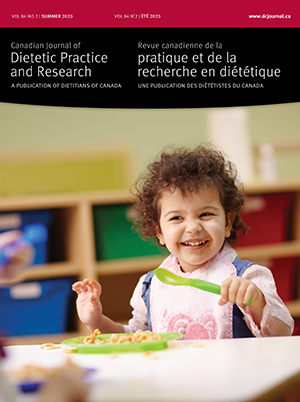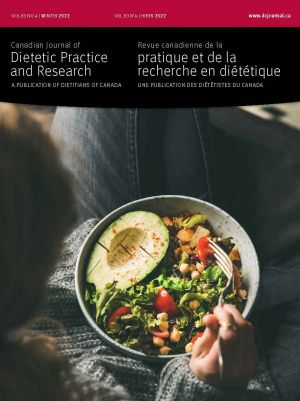Volume 70 • Number 2 • July 2009
Chair’s Message
Editor’s Message
Research
Purpose: Dietary intakes and nutrition behaviours were examined among different diet quality groups of Canadian adolescents. Methods: This cross-sectional study included 2850 Alberta and Ontario adolescents aged 14 to 17, who completed a self-administered web-based survey that examined nutrient intakes andmeal behaviours (meal frequency andmeal consumption away from home). Results:Meanmacronutrient intakes were within Acceptable Macronutrient Distribution Ranges; however,micronutrient intakes andmedian food group intakes were below recommendations based on Canada's Food Guide to Healthy Eating (CFGHE). Overall diet quality indicated that 43%, 47%, and 10%of students had poor, average, and superior diet quality, respectively. Adolescents with lower diet quality had significantly different intakes of macronutrients and CFGHE-defined “other foods.” In terms of diet quality determinants, those with poor diet quality had higher frequencies of suboptimalmeal behaviours. Students with poor diet quality consumed breakfast and lunch less frequently than did those with average and superior diet quality. Conclusions: Canadian adolescents have low intakes of CFGHE-recommended foods and high intakes of “other foods.” Those with poor diet quality had suboptimal macronutrient intakes and increased meal skipping and meal consumption away from home. Adherence to CFGHE may promote optimal dietary intakes and improve nutritional behaviours.
Purpose: This study was conducted to determine consumer understanding and retention of nutrition information presented at grocery stores during the Paint Your Plate campaign via two approaches: interactive display events and brochure distribution. Methods: Data were collected at 17 grocery stores in northern Ontario. Eleven stores held interactive display events with public health staff, a display, resources, and food samples. Six stores only distributed brochures. A total of 688 participants completed a baseline questionnaire, and 432 consented to a three-month follow- up telephone call. Of these, 201 were randomly selected to participate. Results: Participants at interactive display events were six times more likely than participants receiving brochures to identify a serving size of fruit and vegetables (odds ratio [OR]=5.88; 95%confidence interval [CI]: 4.05, 8.54) and 23 timesmore likely to identify the recommended number of servings of fruit and vegetables (OR=22.67; 95%CI: 14.29, 35.98).However, at follow-up, there was no significant difference between type of event and the ability to answer correctly. Conclusions: Interactive displays increased immediate knowledge but failed to increase retention, a finding that suggests consistent presence of the message is needed to reinforce initial understanding and retention. More emphasis should be placed on directing funding toward increasing the frequency and duration of promotional efforts.
Purpose: The relationships among dietary behaviours, traditional health beliefs (THB), and demographic characteristics of Chinese Canadians living in Toronto were examined, as were their primary sources of nutrition information. Methods: Through the use of probability sampling, 106 adult subjects who originated fromChina, Hong Kong, or Taiwan were recruited fromfive Chinese community organizations. A telephone interview, employing a tested questionnaire, was conducted in Cantonese orMandarin. All data were analyzed with MS Excel and SPSS statistical software. Results: Dietary acculturation is gradual and individual. Participants reported regular intakes of fruits and vegetables and fat-reducing behaviours. Most used both Chinese and Western cooking methods. Practices based on traditional Chinese health beliefs (THB), such as balancing yin and yang foods to promote health, were prevalent. Participants were grouped as THB-strong, THB-moderate, or THB-weak, on the basis of their health belief scores. Various significant relationships among the variables were identified. Chinese media, friends, and family were the primary sources of nutrition information; dietitians were identified by only 12%. Conclusions: This is the first study to apply a THB grouping for Chinese Canadians. Results will provide an important basis for nutrition interventions to encourage immigrants to make healthy food choices, using both traditional and Western foods.
Perspectives in Practice
Several health disciplines have incorporated the arts into professional education programs; however, little work has been done in the field of dietetics. A pilot arts module was implemented as part of a graduate education program in community nutrition. The course instructor developed a structured, open-ended questionnaire, which was administered to participating students before the educational module. The same students completed a similar questionnaire at the end of the module. Responses were compared and analyzed thematically so that changes could be noted in perspectives on the arts and health upon module completion. Findings suggested that students' understanding of “art” and “science” changed during the module, that they recognized benefits of incorporating the arts into community nutrition practice, and that they could identify resources that would support their efforts to do so. The positive student responses to this pilot project support the further development of arts initiatives within dietetic education.
Report
Purpose: Obesity in childhood has become a major public health concern because of increasing rates of overweight and obesity. To address this epidemic, effective dietetic interventions must be developed. We examined parent/caregiver and/or patient reasons for not returning for follow-up clinical care in the Alberta Health Services, Edmonton Area's Nutrition Services Pediatric Weight Management Program (NS PWMP) in Edmonton, Alberta. Methods: A qualitative telephone survey was developed to identify reasons for non-return to the NS PWMP. Face validity was evaluated by five pediatric registered dietitians (RDs). Results: The survey was administered to parents/caregivers of children or adolescents aged 2.5 to 14.2 years (n=21) who attended fewer than two appointments in the NS PWMP. The major reasons for non-return included physical barriers (scheduling, parking, location), organizational barriers (clinic environment), and program educational content (type of educational tools, the focus of lifestyle education on the individual rather than the family, physical activity interventions, and appropriateness of information for the parent or child). Conclusions: Development and delivery of effective dietetic interventions for children and adolescents at risk of overweight and obesity may be achieved by emphasizing skill building within the child and the family. Analysis of child and family feedback on clinical RD services is critical to optimization of care in a pediatric weight management program.
Purpose: Beverage consumption by poor, lone mother-led, “milk-friendly” families living in Atlantic Canada was characterized over a one-month income cycle. Methods: Beverage intake and food security status were assessed weekly, using a 24-hour dietary recall and the Cornell- Radimer food insecurity questionnaire. Families were classified as “milk friendly” if total consumption of milk was 720 mL on a single day during the month. Beverage intake was assessed using t-tests, analysis of variance (ANOVA), repeated measures ANOVA with post hoc comparisons, and chi-square analysis. Results: Milk consumption by milk-friendly families (76; total sample, 129) was highest at the time of the month when they had the most money to spend. During all time intervals, mothers consumed the least amount of milk and children aged one to three years consumed the most. Mothers consumed carbonated beverages disproportionately, while children of all ages consumed more fruit juice/drink. Mothers’ coffee consumption was profoundly increased when either they or their children were hungry. Conclusions: The quality of beverage intake by members of low-income households fluctuates in accordance with financial resources available to purchase foods. Mothers’ beverage intake is compromised by the degree of food insecurity the family experiences.
Purpose: The Healthy Eating Champions Award for Elementary Schools (HEC) is a public health initiative that recognizes and rewards schools for their outstanding commitment to the promotion of nutrition, for nutrition education, and for making healthy foods and beverages available. This process evaluation assessed HEC implementation, identified benefits and barriers, and solicited suggestions for program improvement. Methods: In-person interviews with principals or their designates from 28 HEC participating schools were conducted in fall 2006. Results: Participants had positive feelings about the HEC program and shared many success stories. Perceived program benefits included increased student awareness about healthy eating, more student involvement in healthy eating initiatives, the creation of opportunities for goal setting and spirit boosting, and improved hygiene practices. The challenge of getting parents and teachers involved and the significant financial needs of schools in low-income areas were identified as challenges. Conclusions: Participants view the HEC program as having a positive impact on the healthy eating environment in schools.










